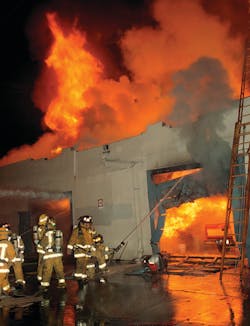20 Tough Questions For the Fire Chief: Are You Prepared To Answer Them? Question 3
A successful response to this question can be reviewed as having three distinct parts: staffing, response time and resources (i.e., apparatus). Resources, in the form of apparatus required to get the staff to the emergency in a timely fashion, has become a contentious issue.
In an environment where many organizations are experiencing reduced funding, the fire chief must be able to justify how he or she determines the “right” amount of resources needed to efficiently and effectively manage an emergency. Each community individually determines its precise resource needs.
Be prepared
Presenting factual data that captures, appraises and predicts current and future outcomes is imperative to mounting a successful defense. Here are some recommendations to answer this tough question:
• Begin with a realistic assessment of the fire department budget, both expenditures and revenue. Anticipate factors such as legislative actions that may impact your future budgets.
• Scrutinize your budget internally. For example, look at your fleet costs in terms of fuel and overhead. Look for efficiencies in the fleet operational costs by considering the use of smaller vehicles to respond to calls for service that may not need a full-sized engine company.
• Conduct a retrospective analysis of your calls and call patterns. For simplicity, we will examine metrics to consider for structure fires.
? Evaluate call volume, time of day, day of week, frequency of occurrence, location, occupancy type, staffing and outcomes.
? Look at responses to protected (sprinklered) and non-protected properties. Examine the same criteria as above, with particular attention given to the outcome. If the property was protected, what role did a heavy response of fire apparatus contribute to the outcome?
? Consider developing a demographic profile for the various demographic regions you serve, giving consideration to the number of multi-family occupancies in one region of your town compared to another that may be primarily single-family residential.
? The distribution and concentration of fire stations will assist in determining the “right” resources. Partnering with neighboring communities may also improve service delivery and reduce costs. It can be very productive when there is cooperation to send the closest unit. Partnering also makes sense when there are response-time challenges due to geographic, roadway configurations or staffing challenges (e.g., low staffing levels in certain periods of the day).
• Evaluate your staffing model. Evaluate the staffing of your previous emergencies to determine if and when you are able to staff your companies with your pre-determined minimum staffing (e.g., four firefighters on every call). Determine if your department can realistically and financially meet your staffing standard.
Analyze call data
In some departments, the number of firefighters available to respond to an emergency can be a persistent challenge. If a department is consistently understaffed, it could consider smaller response vehicles. Ideally, there should be sufficient redundancy or overlap in your system to handle simultaneous calls or a high call volume without compromising the safety of the public or firefighters.
After evaluating your historical call data, consider developing a response matrix. The matrix pre-establishes the response resources desired for each type of emergency. For example, low-risk calls may be handled with two firefighters in a utility vehicle or a mini pumper. This type of measured response can keep remaining on-duty personnel available for other duties.
Develop and communicate your department’s response goals and objectives. Align your response matrix with your benchmark and consider realigning resources to meet your goals. For example, the objective might be to have 15 firefighters at a structure fire in less than 10 minutes for 90% of the time.
For EMS responses, the concepts are the same. Evaluate the metrics previously described and complete a historical analysis to assist in developing a response matrix. Many EMS systems have successfully applied these concepts to predicting resource needs during high call volume periods. Consider parsing the EMS response matrix based on the severity of the emergency (e.g., life-threatening versus non-emergency calls). If your department responds to medical calls with a fully staffed engine company, consider whether responding those resources are always appropriate for the type of emergency. For some types of medical calls, a response of two personnel in a smaller vehicle may be more efficient.
Right-sized responses
As resource needs are evaluated, involve all levels of the organization in the process. Keeping personnel informed and involved will improve understanding and cooperation. It will be important to ensure your elected officials and the citizens are informed of the resources and service levels they can expect. Each level has a cost. When resource levels are low, there will be a potential consequence. Use factual data, applied in a logical manner, to justify your resource-allocation decisions.
To answer this tough question, fire department administrators may have to engage in tough discussions with elected officials, fire department members and citizens. The expectations of each group may vary widely and may be driven by different motives. The fire department administrator’s job is to be an educator and an advocate for right-sized responses that ensure firefighter and public safety.
RICHARD B. GASAWAY, Ph.D., served 30 years in public safety, including 22 years as a chief fire officer, before retiring in 2009. He holds bachelor’s, master’s and a doctor of philosophy degrees in finance, economics, business administration and leadership and is the principal consultant at the Gasaway Consulting Group. Dr. Gasaway is the host of the Leader’s Toolbox podcast radio show on Firehouse.com and runs the Situational Awareness Matters! website www.SAMatters.com. RICHARD C. KLINE has been the fire chief for the City of Plymouth, MN, since 1992 and is a senior associate at the Gasaway Consulting Group. He a master’s degree in public safety and is a credentialed chief fire officer through the Commission on Public Safety Excellence. Kline is the chairman for the Minnesota State Fire Chief Association’s Safety and Health Committee. The authors can be reached at: [email protected] or 612-548-4424.






